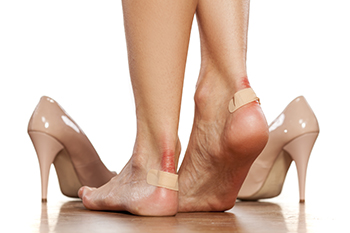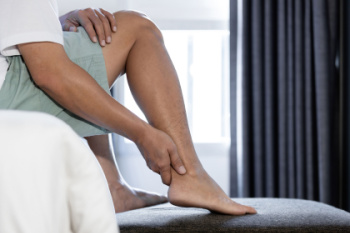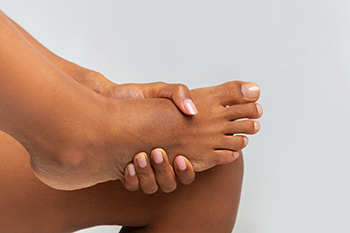Items filtered by date: February 2024
Possible Relief for Chronic Pain After Ankle Sprains
 Managing chronic ankle pain after spraining an ankle can be frustrating, but there are effective treatments that can help alleviate discomfort and enhance recovery. A podiatrist will typically conduct a thorough assessment to understand the specific issues contributing to the chronic pain. Treatment may involve targeted exercises to strengthen the ankle, improve flexibility, and enhance overall stability. Supportive interventions, like ankle braces or orthotic inserts, can provide additional support, promoting proper alignment and reducing strain on the affected area. Podiatrists may also recommend anti-inflammatory medications to manage pain. Rehabilitation plans are tailored toward the individual and their unique injury, addressing the root cause of the ankle pain. If you are experiencing pain after an ankle sprain, it is suggested you schedule an appointment with a podiatrist who can examine your ankle and create the right treatment plan for you.
Managing chronic ankle pain after spraining an ankle can be frustrating, but there are effective treatments that can help alleviate discomfort and enhance recovery. A podiatrist will typically conduct a thorough assessment to understand the specific issues contributing to the chronic pain. Treatment may involve targeted exercises to strengthen the ankle, improve flexibility, and enhance overall stability. Supportive interventions, like ankle braces or orthotic inserts, can provide additional support, promoting proper alignment and reducing strain on the affected area. Podiatrists may also recommend anti-inflammatory medications to manage pain. Rehabilitation plans are tailored toward the individual and their unique injury, addressing the root cause of the ankle pain. If you are experiencing pain after an ankle sprain, it is suggested you schedule an appointment with a podiatrist who can examine your ankle and create the right treatment plan for you.
Ankle pain can have many different causes and the pain may potentially be serious. If you have ankle pain, consult with Dr. Kevin Davis from Davis Foot & Ankle Centers. Our doctor will assess your condition and provide you with quality foot and ankle treatment.
Ankle pain is any condition that causes pain in the ankle. Due to the fact that the ankle consists of tendons, muscles, bones, and ligaments, ankle pain can come from a number of different conditions.
Causes
The most common causes of ankle pain include:
- Types of arthritis (rheumatoid, osteoarthritis, and gout)
- Ankle sprains
- Broken ankles
- Achilles tendinitis
- Achilles tendon rupture
- Stress fractures
- Tarsal tunnel syndrome
- Plantar fasciitis
Symptoms
Symptoms of ankle injury vary based upon the condition. Pain may include general pain and discomfort, swelling, aching, redness, bruising, burning or stabbing sensations, and/or loss of sensation.
Diagnosis
Due to the wide variety of potential causes of ankle pain, podiatrists will utilize a number of different methods to properly diagnose ankle pain. This can include asking for personal and family medical histories and of any recent injuries. Further diagnosis may include sensation tests, a physical examination, and potentially x-rays or other imaging tests.
Treatment
Just as the range of causes varies widely, so do treatments. Some more common treatments are rest, ice packs, keeping pressure off the foot, orthotics and braces, medication for inflammation and pain, and surgery.
If you have any questions, please feel free to contact our office located in Springfield, TN . We offer the newest diagnostic and treatment technologies for all your foot care needs.
Shoe Choices That May Lead to Foot Blisters

The selection of appropriate footwear plays a pivotal role in maintaining foot health and comfort, yet certain shoe types can inadvertently contribute to the formation of painful blisters. Wearing ill-fitting shoes, characterized by tightness or inadequate space for the toes to move freely, often creates friction and pressure points against the skin, leading to blister formation. High heels, particularly those with a narrow toe box and stiff materials, force the feet into unnatural positions, increasing the risk of blisters on the toes and heels due to constant rubbing and pressure. Similarly, shoes with rough seams, abrasive materials, or poorly cushioned interiors can result in friction and irritation, promoting blister development. Additionally, shoes made from non-breathable materials trap moisture and heat, creating a conducive environment for blister-causing friction and skin irritation. If you are seeking more information about what to look for in shoes that can prevent blisters, it is suggested that you consult a podiatrist who can provide you with useful tips.
Blisters may appear as a single bubble or in a cluster. They can cause a lot of pain and may be filled with pus, blood, or watery serum. If your feet are hurting, contact Dr. Kevin Davis of Davis Foot & Ankle Centers. Our doctor can provide the care you need to keep you pain-free and on your feet.
Foot Blisters
Foot blisters are often the result of friction. This happens due to the constant rubbing from shoes, which can lead to pain.
What Are Foot Blisters?
A foot blister is a small fluid-filled pocket that forms on the upper-most layer of the skin. Blisters are filled with clear fluid and can lead to blood drainage or pus if the area becomes infected.
Symptoms
(Blister symptoms may vary depending on what is causing them)
- Bubble of skin filled with fluid
- Redness
- Moderate to severe pain
- Itching
Prevention & Treatment
In order to prevent blisters, you should be sure to wear comfortable shoes with socks that cushion your feet and absorb sweat. Breaking a blister open may increase your chances of developing an infection. However, if your blister breaks, you should wash the area with soap and water immediately and then apply a bandage to the affected area. If your blisters cause severe pain it is important that you call your podiatrist right away.
If you have any questions, please feel free to contact our office located in Springfield, TN . We offer the newest diagnostic and treatment technologies for all your foot care needs.
Repairing a Torn Achilles Tendon

Recovering from a torn Achilles tendon necessitates a strategic approach, wherein the guidance of a podiatrist can prove invaluable. Whether opting for surgical intervention or a non-surgical route, the journey entails careful progression and diligent rehabilitation. Following initial immobilization, facilitated by a plaster cast, the rehabilitation plan, overseen by a podiatrist, emphasizes gradual reintroduction of movement, range of motion exercises, and flexibility work. Surgical interventions similarly involve a period of postoperative immobilization, followed by structured rehabilitation under the supervision of a podiatrist. The anticipated timeline for recovery spans approximately six to nine months. Close monitoring by a podiatrist ensures proper loading of the healing tendon while mitigating the risk of reinjury. Heat therapy, ice application, and flexibility training, all incorporated into the rehabilitation regimen, play pivotal roles in fostering optimal healing. Patience, adherence to the prescribed plan, and collaboration with a podiatrist are needed for achieving successful outcomes and restoring function and strength to the injured tendon. If you have injured your Achilles tendon, it is suggested that you schedule an appointment with a podiatrist for an exam and treatment options.
Achilles tendon injuries need immediate attention to avoid future complications. If you have any concerns, contact Dr. Kevin Davis of Davis Foot & Ankle Centers. Our doctor can provide the care you need to keep you pain-free and on your feet.
What Is the Achilles Tendon?
The Achilles tendon is a tendon that connects the lower leg muscles and calf to the heel of the foot. It is the strongest tendon in the human body and is essential for making movement possible. Because this tendon is such an integral part of the body, any injuries to it can create immense difficulties and should immediately be presented to a doctor.
What Are the Symptoms of an Achilles Tendon Injury?
There are various types of injuries that can affect the Achilles tendon. The two most common injuries are Achilles tendinitis and ruptures of the tendon.
Achilles Tendinitis Symptoms
- Inflammation
- Dull to severe pain
- Increased blood flow to the tendon
- Thickening of the tendon
Rupture Symptoms
- Extreme pain and swelling in the foot
- Total immobility
Treatment and Prevention
Achilles tendon injuries are diagnosed by a thorough physical evaluation, which can include an MRI. Treatment involves rest, physical therapy, and in some cases, surgery. However, various preventative measures can be taken to avoid these injuries, such as:
- Thorough stretching of the tendon before and after exercise
- Strengthening exercises like calf raises, squats, leg curls, leg extensions, leg raises, lunges, and leg presses
If you have any questions please feel free to contact our office located in Springfield, TN . We offer the newest diagnostic tools and technology to treat your foot and ankle needs.
It's Time for Beautiful Feet
Top of the Foot Pain

Pain on the top of the foot is a common issue that can often improve within a few weeks. Common causes of top of foot pain include intense or repetitive exercise, wearing tight shoes, and conditions like gout or tendonitis. To alleviate top of foot pain, a podiatrist may recommend rest and elevating the affected foot whenever possible. Wearing shoes that provide ample room for your feet, have a low heel, and a soft sole is recommended for comfort and support. Consider using soft insoles or shoe pads to cushion the affected area. If you are overweight, losing weight may reduce the stress on your feet. Engage in gentle stretching exercises for your feet and ankles to promote flexibility. Avoid engaging in sports or activities that exacerbate the pain, and refrain from prolonged walking or standing. Wearing high heels or tight shoes should also be avoided. If you have this type of pain and it persists, it is suggested that you schedule an appointment with a podiatrist for a proper diagnosis and treatment options.
Foot Pain
Foot pain can be extremely painful and debilitating. If you have a foot pain, consult with Dr. Kevin Davis from Davis Foot & Ankle Centers. Our doctor will assess your condition and provide you with quality foot and ankle treatment.
Causes
Foot pain is a very broad condition that could be caused by one or more ailments. The most common include:
- Bunions
- Hammertoes
- Plantar Fasciitis
- Bone Spurs
- Corns
- Tarsal Tunnel Syndrome
- Ingrown Toenails
- Arthritis (such as Gout, Rheumatoid, and Osteoarthritis)
- Flat Feet
- Injury (from stress fractures, broken toe, foot, ankle, Achilles tendon ruptures, and sprains)
- And more
Diagnosis
To figure out the cause of foot pain, podiatrists utilize several different methods. This can range from simple visual inspections and sensation tests to X-rays and MRI scans. Prior medical history, family medical history, and any recent physical traumatic events will all be taken into consideration for a proper diagnosis.
Treatment
Treatment depends upon the cause of the foot pain. Whether it is resting, staying off the foot, or having surgery; podiatrists have a number of treatment options available for foot pain.
If you have any questions, please feel free to contact our office located in Springfield, TN . We offer the newest diagnostic and treatment technologies for all your foot care needs.

